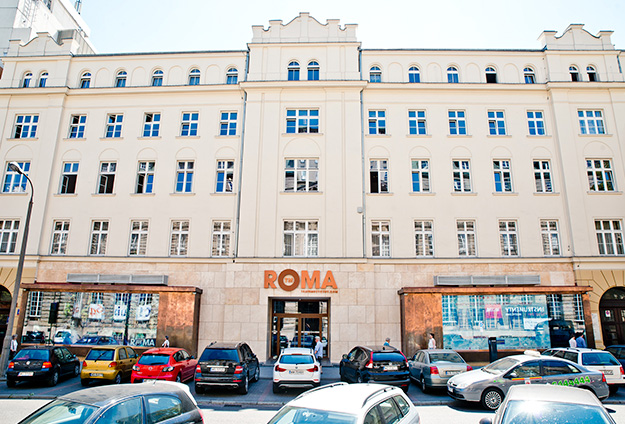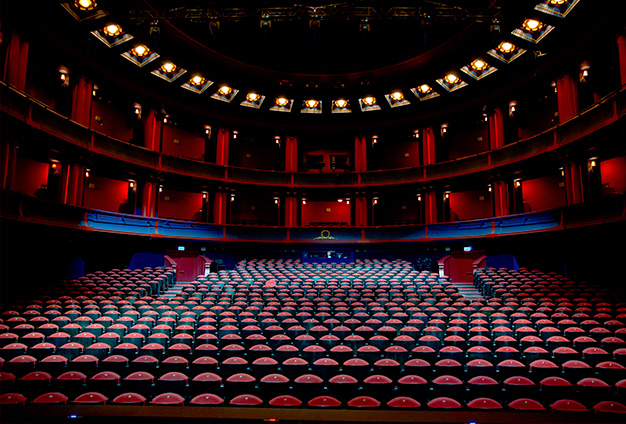Theatre History
SECRETS OF THE ROMA THEATRE IN WARSAW
In the centre of Warsaw, on the site of a former cemetery where traitors and sell-outs were buried, stands a building that for 80 years has withstood the vagaries of history. It was a place of youth conventions, a cinema, a vaudeville house, a brothel and a theatre. Only capitalism can destroy it.
Warsaw, July 21, 1941. Elegant limousines pull up in front of the military casino on Nowogrodzka Street, a representative building decorated with Nazi flags. The sound of the clicking of heels and shouts of “Heil Hitler!, Heil Hitler!” testify that the head of the General Government, Hans Frank, has arrived. And with his arrival, the screening of the film Jud Süss [Jew Süss] can begin – the most anti-Semitic picture in the history of not only German, but also world, cinema.
This premiere in Warsaw’s Roma movie theatre, annexed to become a German casino, vaudeville house and brothel, was to be the crowning glory of ‘German Days’, an event intended to boost the morale of Nazi officers stationed in Warsaw. After one screening of the film in Marseille, an outraged crowd from the audience had organised a pogrom in the Jewish quarter. In occupied Warsaw, however, it was more difficult to expect such a spectacular action because, in the Roma auditorium, the film by Nazi director Veit Harlan would be seen only by a carefully selected group of two thousand dignitaries and officials of the Third Reich.
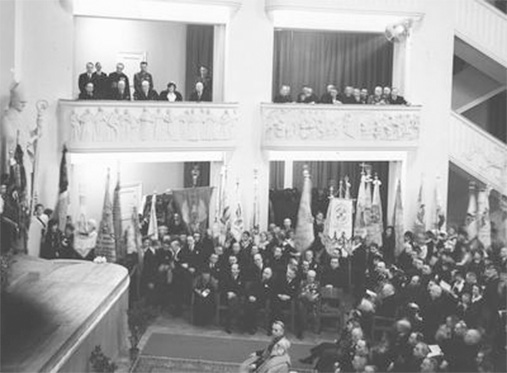
RATS AT THE SCREENING
A month earlier, the German invasion of the Soviet Union had begun with the impressive Blitzkrieg – within just a dozen days or so, Wehrmacht units had taken over Lithuania, Latvia, Estonia, Belarus and a large part of Ukraine, and reached Smolensk – giving Hitler hope that he was merely days away from a triumphant parade in Red Square. Even though the German leader would not be in Warsaw, a group of Poles decided to carry out a minor act of sabotage in the Roma theatre anyway.
We know how it looked thanks to the memoirs of “Mścisław”, namely Teodor Niewiadomski, a worker and athlete who was employed during the occupation by the Municipal Department of Sanitation (ZOM). It was he who, along with four other members of the resistance movement, was given the task of planting rats in the Roma theatre, which were to be released between the legs of the dignitaries with the intention not so much of causing disgust but more of creating panic among the audience. The cage containing the rodents was padlocked – which would be eaten through by acid at the appointed time. The entire quarter around the Roma theatre was cordoned off, but the “garbage men” managed to convince the gendarmes to let them through into the courtyard of the movie theatre, where the refuse bins stood. The first part of the plan was therefore accomplished. Unfortunately, during the transfer, the cage containing the rats fell open and the rodents scurried off across the street. Fortunately, the Germans observing this whole scene had no idea what these uniform-clad ZOM employees were actually up to; so they contented themselves with beating the unfortunate “garbage men” with their rifle butts. The Poles escaped, and the premiere of Jud Süss proceeded without interruption. The Roma Theatre, however, had a completely different role to play in Polish history.
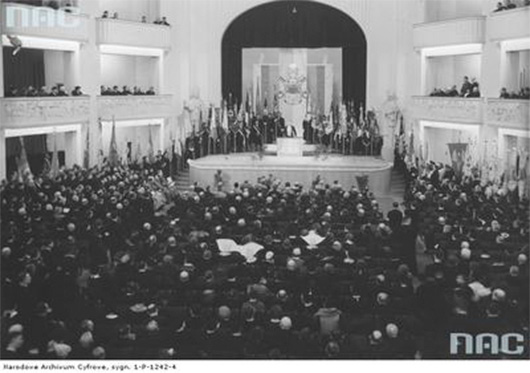
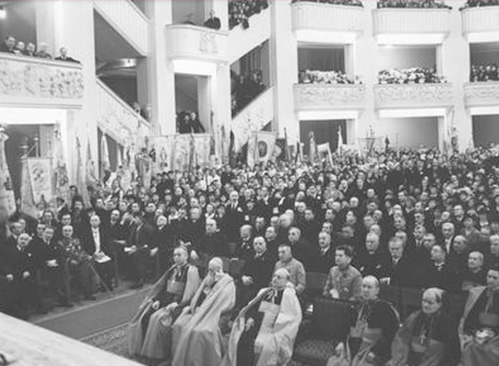
THE CINEMA ON A CEMETERY
The building of the Pius XI Catholic Home, known as the “Roma”, had its ceremonial opening in 1936. It was built on the former site of one of Warsaw’s largest necropolises, the Świętokrzyskie Cemetery.
Even today, if you look through the windows at the point where St Barbara’s Street bends at a right angle to Nowogrodzka Street, you will see a basement modelling room with a whole wall covered with old tombstones. Uncovered during the earthworks, they were all put together in one place and – because nobody had a better idea – set into the wall. This is the last reminder of the 130,000 Varsovians who were buried here between 1783 and 1836. Most of them were buried in the catacombs, including the leaders of the Targowica Confederation, who were hanged for treason during the Kosciuszko Insurrection in 1794: hetmans Piotr Ożarowski and Józef Zabiełło, castellan Józef Ankwicz and, later, the most famous Russian agent of those times, the Marshal of the Partition Sejm, prince Adam Poniński (in Jan Matejko’s painting “Reytan”, Poniński is standing in the centre in red breeches and pointing at Russian soldiers lurking outside the door to the Sejm). Most of the catacombs were demolished in the nineteenth century, and in their place, in the mid-1930s, one of the most famous architects connected with the Warsaw curia, Stefan Szyller, designed a representative building where Catholic youth conventions could take place.
The Roma building was built in a neo-Renaissance style. After it underwent several reconstructions in the twentieth century, there is not much evidence of this left now, but if we stand on the steps of the Agricultural Bank located opposite and raise our head, we can see the attics over the theatre’s façade – similar to those found in tenement houses in Zamość. The building primarily housed a large auditorium for audiences of up to two thousand people. The two-storey underground part contained spacious aircraft shelters, which would come in handy three years after the Roma opened. Before the first German bombs fell on Warsaw, however, the curia decided to “commercialise” the auditorium. A state-of-the-art Western Electric projector was purchased and the Roma was transformed into a cinema. Even many years after the war, when old Varsovians wanted to emphasise that something was a miracle of technology, they would say admiringly: “Well, like the Roma cinema”.

COMMUNIST YOUTHS
The Germans spared the Roma building, although after suppressing the Warsaw Uprising, they painstakingly drilled hundreds of holes into the foundations of the nearby Church of St Peter and St Paul (designed by Józef Pius Dziekoński).
When Varsovians began returning to the capital after 17 January 1945, the only large auditorium remaining in this once million-strong city was located in the Roma. The church could not count on regaining its cinema, however, as the new rulers of Poland moved into the building on Nowogrodzka Street. The first congress of the Polish Workers’ Party was held here, with a triumphant speech by Wladyslaw Gomulka, and the State National Council (KRN) – the fractious, communist-dominated body headed by Boleslaw Bierut – carried out its daily work here. Somehow no one seemed to mind the bas-reliefs adorning the front of the building, on both sides of the main entrance, depicting youngsters being led by priests towards a bright future. Perhaps this style, similar to socialist-realist sculptures, appealed to the communist apparatchiks. It was not until 1953 that someone realised that such scenes were unacceptable in the People’s Republic of Poland. So the decorations were taken down. In their place today are plain glass display cases containing posters for the performances being staged in the Roma.
In January 1947, after the results of the rigged elections to the Constituent Assembly were announced, the KRN ceased its activities and musicians returning to the ruined capital began to flock to the Roma. Professor Stefan Kamasa, a world-renowned viola player, recalled that musicians from the Warsaw Philharmonic joined with musicians from the pre-war Grand Theatre to form a single orchestra and they began rehearsing for concerts and shows. They put beds in rooms that were turned into dressing rooms, with several people at a time crowding together in these cramped quarters, living there and rehearsing for their performances. They were in a better situation than most of the residents of old Warsaw, however, who upon their return found only burnt-out ruins instead of houses.
FROM HALKA TO RAIN
In 1953, the Roma was completely rebuilt. The bas-reliefs were removed, some of the attics were knocked down, drastically changing the appearance of the building’s façade, and the auditorium was halved in size. The premiere performance of Stanisław Moniuszko’s Halka, which inaugurated the new stage, was attended by all “party and state authorities”.
For thirteen years, the National Opera was based here, whose orchestra also gave philharmonic concerts. Musical life was therefore very intense at Nowogrodzka Street. In the mid-1960s, the Grand Theatre building in Teatralny Square was rebuilt (being significantly enlarged compared to its pre-war size), as was the National Philharmonic on Jasna Street. The music ensembles therefore moved to new premises, and the Warsaw Operetta moved into the Roma. For almost the next thirty years, the former Catholic House building was home to the operettas of Johann Strauss and Franz Lehár, where the people of Warsaw applauded the handsome tenor Mieczysław Wojnicki, the soprano Wanda Polańska and, in later years, Grażyna Brodzińska.
Another transformation (but by no means the last) took place in 1994 when Bogusław Kaczyński became the theatre director. He began by restoring the name “Roma”, thus paying tribute to the new/old owners of the building (after the regime change, the Warsaw curia had regained its property). He then went on to create a musical theatre that matched his dreams and ambitions. Continuing to stage operettas, he also decided to include some of the greatest operatic works in the repertoire. Music lovers were somewhat confused, going to the former operetta for a premiere of Carmen by Georges Bizet or Madame Butterfly by Giacomo Puccini.
After less than five years, another change took place and the Roma became a musical theatre under a new artistic director, Wojciech Kępczyński, who decided to break away from its opera-operetta heritage. Staging Roman Polański’s Dance of the Vampires on the small stage of the former lecture hall, or re-creating the scene of a helicopter landing on the roof of the American Embassy (Miss Saigon by Claude-Michel Schönberg) or the labyrinth of the underworld (The Phantom of the Opera by Andrew Lloyd-Webber) required extensive reconstruction of the theatre’s backstage area. The building adaptations were pushed to the limit during the premiere of Singin’ in the Rain. The orchestra pit was removed and turned into a large pool filled with 10,000 litres of water heated to 38 degrees Celsius. Special pumps and sprinklers then made it rain at the appropriate moments from the ceiling down onto the stage below (and the first six rows of the audience).
Sergiusz Pinkwart, source: “Focus Historia”, January 2014
Postscript
After Singin’ in the Rain, the Main Stage was then closed for several months. The reason for this was the extensive renovation of the auditorium, foyer, cloakrooms and toilets – basically, all the public areas for theatre-goers expecting 21st-century comfort. Air conditioning was installed, the orchestra pit was reduced in size slightly and the number of seats in the auditorium was increased to 999.
Throughout this whole time, the Nova Stage, an intimate venue for an audience of 150 that Wojciech Kępczyński had created in the former orchestra rehearsal room in 2009, operated as normal. Unlike the Main Stage, where only one title is staged per season (and performed seven times a week), the Nova Stage is a repertory stage. This atmospheric space has been, and still is, the venue for performances of highly successful domestic musicals for children (e.g. Alice in Wonderland, Adonis Has a Guest, The Adventures of Robinson Crusoe) and adults (Tuwim for Adults, New York. Prohibition), as well as American musicals (Once, The Last Five Years). Since 2014, it has also played host to a series of superb jazz concerts, under the patronage of Krzysztof Herdzin, entitled “Good Evening Jazz”.
The renovated Main Stage was re-opened to audiences in early 2015. On 21st February of that year, the premiere of the musical Mamma Mia! took place – a show featuring the music of the legendary Swedish band ABBA. The premiere evening was even attended by member of the band Björn Ulvaeus. Mamma Mia! proved to be a fantastic repertory choice, running until mid-June 2017 and racking up a total of 562 performances. Only The Phantom of the Opera has been staged at Nowogrodzka Street more times (but not many more, with a total of 572 performances). This latter musical, directed by Wojciech Kępczyński, was later transferred to the Podlasie Opera and Philharmonic in Białystok, where it is still being performed to this day.
After this great success, the ROMA Musical Theatre decided to do something even more difficult and produce its own musical entitled Pilots (book: Wojciech Kępczyński, lyrics: Michał Wojnarowski, music: Jakub Lubowicz and Dawid Lubowicz). This was the third original Polish musical to be staged at the ROMA (following Peter Pan and The Academy of Mr Kleks) but the first one aimed predominantly at adult audiences. This epic and very emotional love story, set during World War II and telling, among other things, of the heroism of Polish air force pilots fighting against the Germans in the Battle of Britain, also proved to be a massive hit, being well received by critics and, above all, by audiences who, as usual, flocked in large numbers to Nowogrodzka Street. From its premiere on October 7, 2017 to June 16, 2019, it was seen by well over 400,000 people and notched up exactly 427 performances during its run (the third highest total in the history of the Roma theatre in terms of the number of performances of a single title). The album featuring music from the show achieved Gold disc status within just a few months.
The 2019/20 season saw Pilots make way for another licensed title. On October 26, 2019, Elton John and Tim Rice’s musical Aida premiered on the Main Stage, to great acclaim. Unfortunately, its great run was interrupted by the coronavirus pandemic. In March 2020, the ROMA Musical Theatre – just like all other theatres and cultural institutions in Poland, and the theatres on Broadway and in the West End – was shut down for a number of months. In 2020 and at the beginning of 2021, theatres were twice briefly allowed to stage productions again – though with audiences limited to 50% and then 25% of capacity. That made it possible to stage dozens more performances of Aida. This title definitely still has plenty of potential left in it and is likely to return to the stage on Nowogrodzka Street in 2022.
The pandemic closure has, of course, also affected the Nova Stage. No performances have been staged there since March 2020 as it has been impossible to adhere to the sanitary restrictions imposed by the authorities. So when the theatres reopened in May 2021 (let’s hope there are no more lockdowns), ROMA MT – due to the restrictions still in force – was only able to return to the Main Stage, although with a completely new production. On 30 May 2021, the Polish premiere of the musical Waitress took place – a title which had debuted on Broadway just five years earlier. For the initial performances, the audience was restricted to 50% of capacity, but this limit was later increased to 75%. The plan is to stage the musical in the 2021/22 season as well, but what about after that? Will Aida return? Will there be a big title from overseas again? Or is it time for another homegrown, original musical? The times are so uncertain that it’s difficult to plan anything with absolute certainty, but one thing is undeniable: ROMA MT will continue to offer lovers of musicals shows of the very highest artistic value.
Michał Wojnarowski
* The gallery of archival photos comes from the National Digital Archives, www.nac.gov.pl
